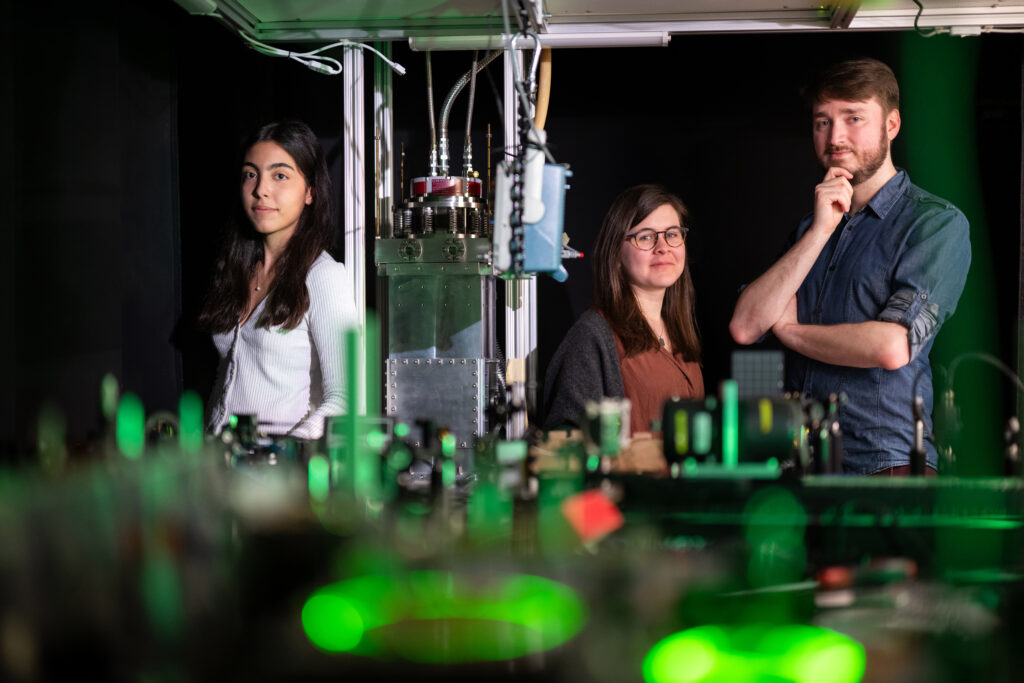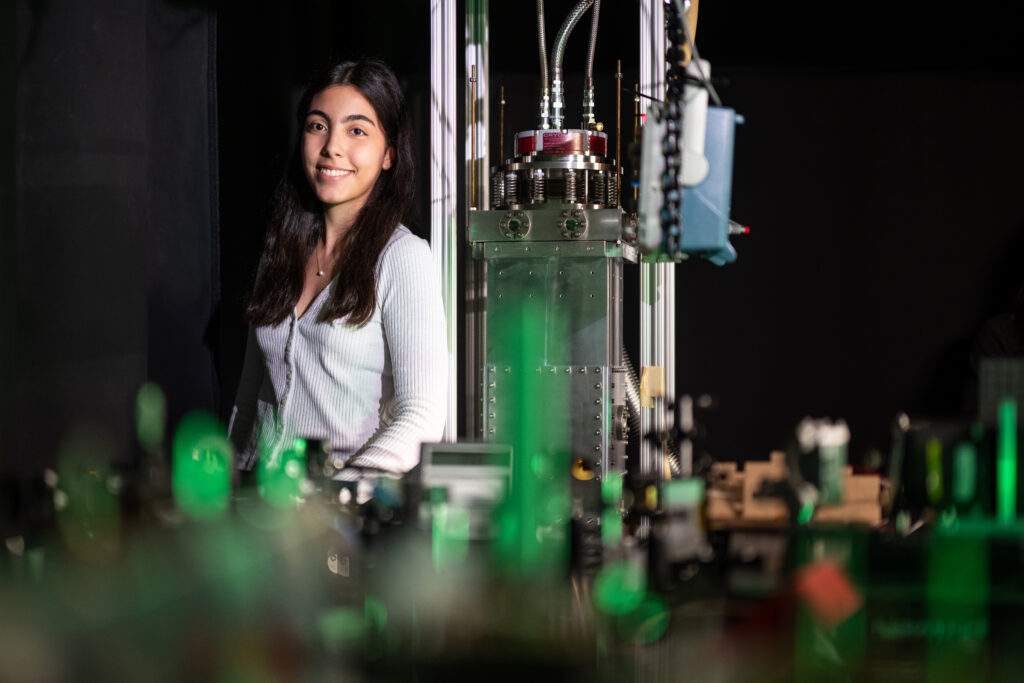Weichman combines astrochemistry, spectroscopy to find molecules in space

In research that has all the makings of a blockbuster movie—with interstellar chemistry, million-year timescales, and high-power lasers—the Weichman Lab is using its expertise in novel spectroscopies to expand our understanding of the composition of the universe.
Backed by a three-year grant from the National Science Foundation (NSF), the research will provide benchmarks to interpret data from NASA’s infrared space telescopes and identify new classes of molecules formed in space.
“These are big, fundamental questions about where we come from and what kind of universe we live in,” said Assistant Professor of Chemistry Marissa Weichman. “The molecules that are out in space are what drive the chemistry of planets and stars and galaxy formation. They’re also the prebiotic origins of life, the seeds of molecules that start life.
“That’s why we’re looking at them.”
Her lab will custom build a device that measures the light absorption of particular kinds of molecules called fullerenes. These geodesic hollow “carbon cages” are the largest group of molecules identified in space so far, and have already redefined our assumptions about molecular complexity in interstellar environments.
Weichman wants to take those assumptions to the next level.

This is a depiction of some fullerene derivatives, building off the C60 molecule, or buckyball, which has a distinct spheroidal, soccer-ball like structure.
As a postdoc five years ago, Weichman published a paper in Science on the simplest C60 fullerenes, colloquially called buckyballs. Now, using the signature spectrum of the buckyball as a benchmark, Weichman will target bigger fullerenes; heterofullerenes, in which carbon atoms have been swapped out for other elements; and endofullerenes, which feature smaller molecules trapped inside the cage.
“Interstellar space is a really strange environment,” Weichman said. “It’s cold. It’s really low-pressure. There are not many molecules in a given amount of space, and the molecules that do exist are constantly being irradiated by ultra-violet radiation and bombarded by cosmic particles. So, the chemistry that happens there is totally different from what happens on Earth.
“For a certain type of molecule to accumulate in space, it has to be able to live for an astronomical timescale, so it has to be very stable. Fullerenes happen to be exceptionally stable and robust against fragmentation. They can last more or less forever in space. Understanding these species is really important for astrochemistry, and spectroscopy is how we detect that a specific given molecule is present.”
New spectrometer device
The Weichman Lab’s spectroscopy apparatus will yield long-wave infrared (LWIR) absorption spectra of fullerenes. Once it’s up and running, researchers will compare their results with data from the space-based infrared observatories—for example the Spitzer Space Telescope—that NASA uses to peer into features otherwise invisible to optical telescopes. Along with locating known forms of fullerenes like C60 and C70, researchers will also try to assign numerous unidentified infrared absorption and emission features that have been observed in space.
“This is still a big research question in astrochemistry. There are all these absorption and emission lines that are completely unresolved. They’re not identified or assigned. They’re not buckyballs. They’re something else,” said Weichman. “So, what are they?”
Helping to address this celestial mystery will be a second-generation apparatus that goes by the unwieldy name of cavity-enhanced frequency comb spectrometer. At the heart of this apparatus is the frequency comb, a special type of laser that outputs multiple frequencies of light simultaneously. These disparate frequencies—which in this case will number in the tens of thousands—are so evenly spaced that they resemble the teeth in a comb; hence the name. When these frequencies are resolved in a spectrometer, researchers can look for absorption signatures to help them say, yes, this is a fullerene; or perhaps more intriguingly, no, this is not.
Dominik Charczun, a postdoc in the Weichman Lab, is an expert in developing new methods for frequency comb spectroscopy.
“Basically, we use quantum chemical methods of generating spectra to anticipate where the absorption features would be. We’re aiming to look at mid-infrared wavelengths, which are around six to 10 microns, because fundamental absorption bands of our target molecules are in this range.
“We will start with measurements for C60, C70 and other fullerenes and derivatives we already know. That’s the goal,” he added. “And if we measure this range of molecules and we don’t find the answer comparing our data with the observational data, then I suppose we will spend quite some time figuring out what other molecules to look at.”
Fullerenes, which are comprised of a large number of atoms, occupy a significant number of rotational and vibrational quantum states at room temperature. This leads to something called spectral congestion, which hinders researchers’ ability to completely resolve the spectra of these molecules.
Graduate student Negar Baradaran has an answer to that. In fact, she designed and assembled the lab’s cryochamber, which will target this aspect of the research.

Graduate student Negar Baradarn stands next to the cryochamber she designed and assembled in the Weichman Lab.
“To overcome this challenge, we use a closed-cycle helium cryocooler that cools down the sample to around 4 to 10 kelvins, similar to the temperatures of the interstellar medium,” said Baradarn. “This allows for higher spectral resolution and facilitates the assignment of quantum states for fullerenes.”
The Weichman Lab already has a strong profile in the emerging field of polariton chemistry, which has to do with chemistry that takes place inside optical cavities. That profile landed Weichman a 2022 grant from the Dean for Research Innovation Fund provided, which provided groundwork funding for this research. And while she acknowledges that astrochemistry marks a new thrust for her lab, it also dovetails nicely with its mission to develop new tools for spectroscopy that explore what molecules are doing quantum mechanically.
Today, researchers nearly have their home-built comb spectrometer ready to go. Weichman’s NSF funding will allow researchers to begin screening for fullerenes.
“Making the measurements of C60 was hard,” said Weichman. “But there is going to be a lot of development just to move beyond C60.”
Added Charczun: “Astronomers use those magnificent space telescopes to gather data but often that data is pretty cryptic, and it’s hard to identify molecules in a lab. These are not simple systems to study. That’s why it’s important to provide cutting-edge, high quality reference data. This is what we aim to do using the newest, best techniques available.”
This project, Precision Spectroscopy of Fullerenes: Towards Resolving Astrophysical Molecular Complexity, has been funded by the National Science Foundation, Division of Astronomical Sciences, with ground-level funding from the Dean for Research Innovation Fund.
